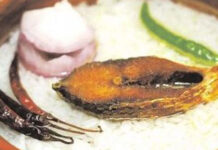The challenges in reviving our jute sector

It seems that the present crisis in the state-owned jute mills will hardly be over with the Tk 169.14 crore allocated by the government to the Bangladesh Jute Mills Corporation (BJMC) to pay the workers their dues. This may placate the workers for the time being, but as their other demands, including implementing the new wage scale, cannot be met with this money, there are chances of further unrest. And unless steps are taken to completely restructure the sector, the problems the sector is currently facing will persist.
After the government allocated funds for the BJMC, one of the workers told The Daily Star: “We have been promised (of arrears) on several occasions in the last two months. How can I believe until I get the money?” There are valid reasons for the workers’ mistrust. During the last two months, the workers got assurances from the authorities several times that their due salaries would be cleared and other demands met. On May 21, the workers of nine state-owned jute mills in Khulna region suspended their indefinite strike on assurances by the BJMC that a portion of their due salaries would be paid by May 23. But they did not live up to that promise. Similar promises were made in April.
But since the government has already allocated funds, one can only hope that the workers will get their dues before Eid. While the BJMC needs Tk 337 crore, the government contributed only Tk 169 crore. So there remains a deficit of Tk 168 crore. This means that the BJMC will not be able to meet the other demands of the workers because of a lack of fund: the implementation of the National Wage Commission of 2015, payment of gratuities and provident funds of retired workers, and appointment of workers and making their jobs permanent as per the law.
Apart from the abovementioned amount, the BJMC needs another Tk 1,600 crore for the implementation of the new wage scale. Currently, the average jute worker’s salary is Tk 4,150 and if the new pay scale is implemented, the amount would rise to Tk 8,300. How will the BJMC pay the workers this increased amount if the mills run at a loss?
The government cannot just continuously inject money into the sector without having a proper plan to revive the sector. Reportedly, during the last decade, the government handed Tk 7,477 crore to the BJMC to bail it out of financial troubles. But sadly, the sector could not stand on its own feet because of corruption, bad management, outdated technology, poor planning and a lack of government initiatives.
Reportedly, the efficiency of the BJMC mills is now below 50 percent. This is because the mills are being run with old machinery bought before the liberation of Bangladesh. Replacing the old machinery with modern ones is the need of the time but it needs a lot of investment. How will the BJMC manage this money?
And in order to increase the export of jute goods to international markets, diversification of products is of utmost importance. We undoubtedly have a pool of talent who can innovate and create. For example, scientists have invented a jute-made biodegradable poly bag called “Sonali Bag”. But to stir innovation, we need to invest in research.
So now the question is: where will the BJMC get the funds to do all the things necessary to make this sector profitable again?
As a first step, the organisation can address the issue of corruption. Corruption and mismanagement in buying raw jute have been major reasons for higher production cost of jute products. Reportedly, the corporation does not buy raw jute during the peak harvesting season in July when one maund of jute sells at Tk 1,000 to Tk 12,000. It buys raw jute in the off-season during October-November, when the same amount of jute sells at Tk 2,000 to Tk 2,200. Also, they buy from the shippers and hoarders, not directly from the farmers. This means that hundreds of crores of taka are wasted in simply purchasing raw jute. Needless to say, this happens because of inefficiency and corruption by a section of BJMC officials. Also, it doesn’t make sense as to why the government would release the funds for buying jute when the season is over. In addition, the government’s allocation of funds for buying raw jute has never been sufficient.
Since the government has provided Tk 169 crore to pay the workers as loan, the BJMC will have to repay the money in the next 20 years. If the BJMC cannot make profit, how will they repay this loan? So, there is simply no alternative to reviving this once profitable sector. And the government has a big role to play here. The prime minister on several occasions has called upon all concerned to make this sector profitable again. That’s a positive sign.
But a recent recommendation of a leading World Bank economist was just the opposite of the conventional way of thinking about our ailing jute sector. While we are talking about reviving the sector—around four crore people are dependent on it for their livelihoods—he recommended that we should find other sustainable ways to support the livelihood needs of jute workers by creating jobs and self-employment opportunities. He also said: “Keeping terminally sick enterprises on life support is not a viable way of protecting the jobs.” Does this mean that the jute sector will cease to exist? Economist Anu Muhammad recently told The Daily Star that many of the state-owned jute mills were closed upon the recommendations of the World Bank in the past. “The once-thriving jute industry has turned into one on the verge of extinction thanks to the continuation of that policy.”
However one construes the recommendations of the World Bank, one thing is for certain: millions are dependent on this sector and breathing life into it is the need of the hour.
Naznin Tithi is a member of the editorial team at The Daily Star.
Source: The Daily Star.









